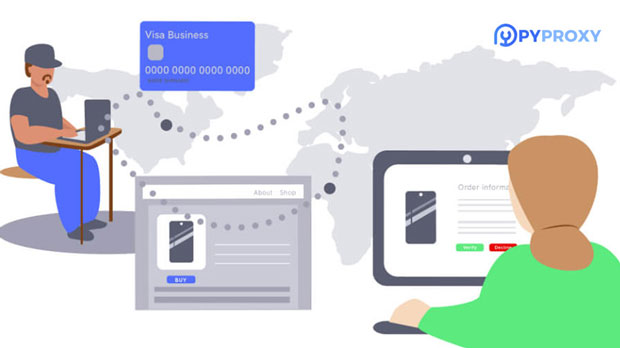How to access Netflix, Hulu, Disney and other streaming media using a free IP proxy?
Streaming services like Netflix, Hulu, Disney+, and others are popular platforms, but they are often restricted based on geographical regions. Due to licensing agreements and local regulations, content on these platforms varies from country to country. For users who wish to access content that isn't available in their region, one solution is to use free ip proxies. These proxies allow users to mask their real IP address, making it appear as though they are browsing from a different location. This article explores how to use free IP proxies to access streaming platforms, the benefits, the limitations, and the steps to get started. Understanding Streaming Restrictions and Geo-blockingStreaming platforms use geo-blocking technology to ensure that content is available only in certain regions. This is typically based on licensing agreements with content providers, which limit where certain movies, TV shows, or documentaries can be shown. For example, Netflix may offer a different selection of shows in the United States than in the United Kingdom. Similarly, Hulu and Disney+ restrict access to their libraries based on a user's location.Geo-blocking can be frustrating for users who want access to a wider range of content, especially when it comes to exclusive series or new releases. While some users turn to paid VPN services to bypass these restrictions, free IP proxies can also be an alternative, albeit with some trade-offs in terms of reliability and speed.What Are Free IP Proxies?IP proxies, also known as proxy servers, act as intermediaries between your device and the internet. When you use a proxy, your internet traffic is routed through the proxy server, which then communicates with websites on your behalf. The website only sees the IP address of the proxy server and not your actual IP address.Free IP proxies work in a similar way, allowing you to hide your real location and make it appear as though you are accessing the internet from a different country. This can help bypass geo-restrictions, allowing you to access streaming platforms that would otherwise be unavailable in your region.There are different types of proxies, including HTTP, SOCKS, and residential proxies. Free proxies typically fall into the category of shared proxies, where multiple users share the same IP address. While this can reduce costs, it also increases the chances of performance issues, such as slow speeds and potential security risks.How to Use Free IP Proxies for StreamingIf you're looking to use a free ip proxy to access streaming services, follow these steps:1. Find a Reliable Free IP ProxyThere are various websites that list free IP proxies that are publicly available. These proxies are often listed with details about their location, speed, and the types of protocols they support. When selecting a proxy, it's important to consider the location of the proxy server. If you want to access Netflix US, for example, you would need a proxy server based in the United States. However, keep in mind that free proxies are often less reliable than paid options. They may be slower, more prone to disconnection, and sometimes not work at all with popular streaming platforms. Some proxies may also be blacklisted by streaming services, making them ineffective for bypassing geo-restrictions.2. Configure the Proxy SettingsOnce you've found a proxy, you'll need to configure your device to use it. This typically involves entering the proxy server's IP address and port number into your browser or streaming device’s network settings. Some streaming apps or services may require you to input additional settings, such as the type of proxy (HTTP, SOCKS, etc.).For example, to configure the proxy on a browser, go to the network settings and enter the proxy ip and port. After saving the settings, your internet traffic will be routed through the proxy server, and streaming services will recognize the proxy’s IP address rather than your own.3. Test Your ConnectionAfter configuring the proxy, it's important to test the connection. Open a streaming platform like Netflix, Hulu, or Disney+, and check if you're able to access content from the desired region. If the proxy is working correctly, you should see content available in that country.If you encounter issues, try using a different proxy or adjusting the settings. Keep in mind that not all free proxies will work with every platform, as streaming services frequently update their systems to detect and block proxies.4. Monitor Your Streaming ExperienceOnce you’re able to access the content you want, you may want to monitor your streaming experience. Free proxies can sometimes cause buffering, slow loading times, or even connection drops. These issues are typically the result of shared resources, where multiple users are accessing the same proxy server at once.To ensure a smooth experience, it's important to keep an eye on the speed and performance of the proxy. If you notice significant issues, try switching to a different proxy or accessing the content at a different time when the proxy may be less congested.Benefits of Using Free IP Proxies for Streaming1. Cost-Effective SolutionThe most obvious advantage of using free IP proxies is that they don’t cost anything. While paid VPN services can be expensive, free proxies offer a way to bypass geo-restrictions without incurring extra costs.2. Easy to Set UpSetting up a free IP proxy is generally straightforward. Most proxy services provide simple instructions for configuring your device or browser, making it accessible even for users with limited technical knowledge.3. Access to Global ContentFree proxies allow you to access content from any country where the proxy server is located. This opens up a world of streaming options, allowing you to watch shows, movies, and documentaries that might otherwise be restricted in your region.Limitations of Free IP Proxies1. Reliability IssuesFree proxies are often unreliable, especially when it comes to streaming. They can be slow, unstable, and prone to disconnection. This can result in buffering, lag, or the inability to access streaming platforms at all.2. Security RisksUsing free IP proxies can expose you to security risks. Since free proxies are often shared by multiple users, there's a higher chance of malicious actors intercepting your data. Additionally, free proxies may not encrypt your traffic, leaving you vulnerable to cyberattacks.3. Limited AccessSome streaming platforms actively block known proxy ip addresses, making it difficult for free proxies to work with services like Netflix, Hulu, and Disney+. As a result, free proxies may not always be effective for bypassing geo-restrictions.ConclusionUsing free IP proxies to access streaming platforms like Netflix, Hulu, and Disney+ can be a viable solution for bypassing geo-blocks and accessing content from other regions. However, the reliability and security of free proxies may vary, and they often come with limitations like slow speeds and potential security risks. For users who are willing to accept these drawbacks, free proxies can provide a cost-effective way to unlock a wider variety of content.
2025-01-30
























































